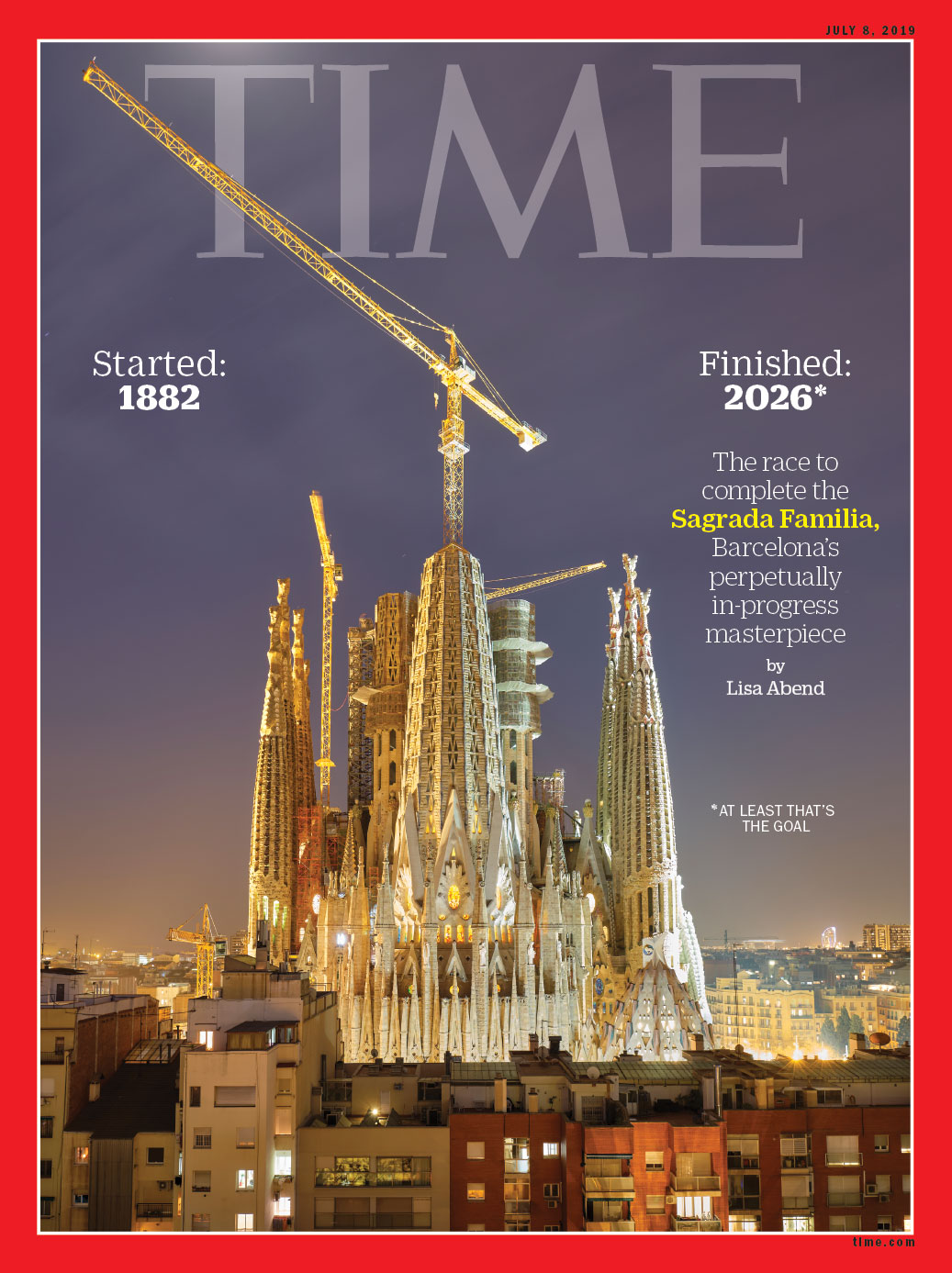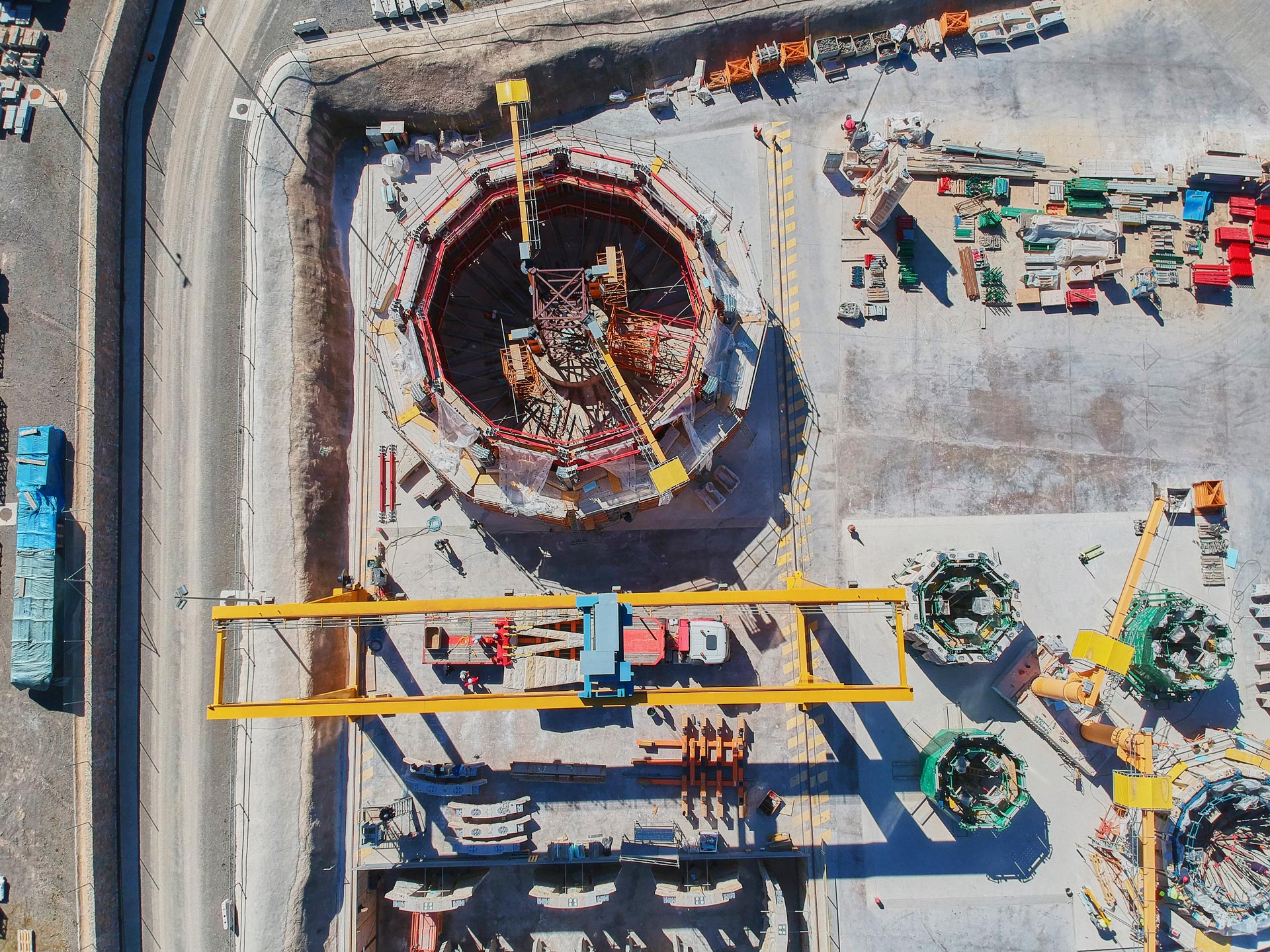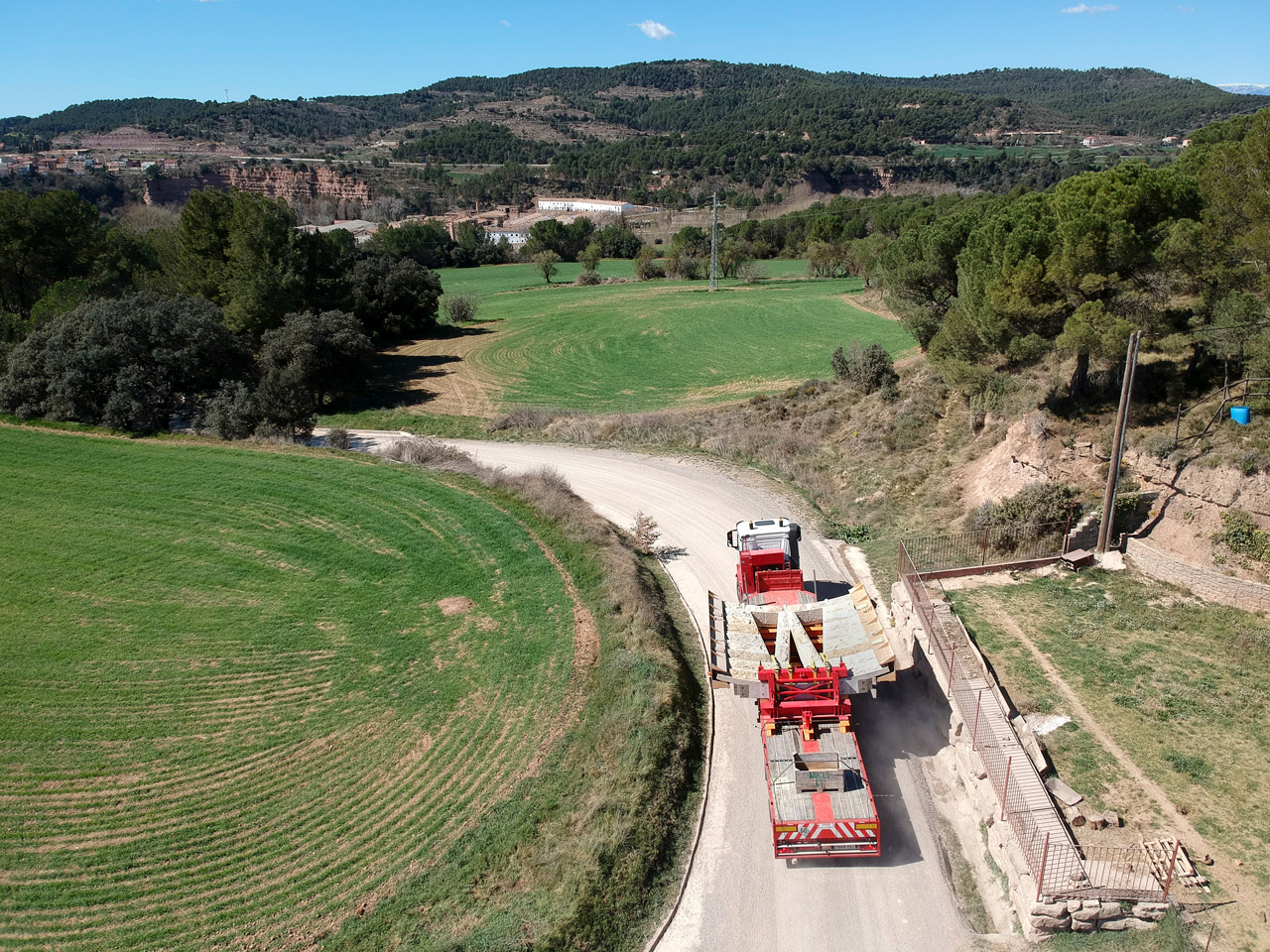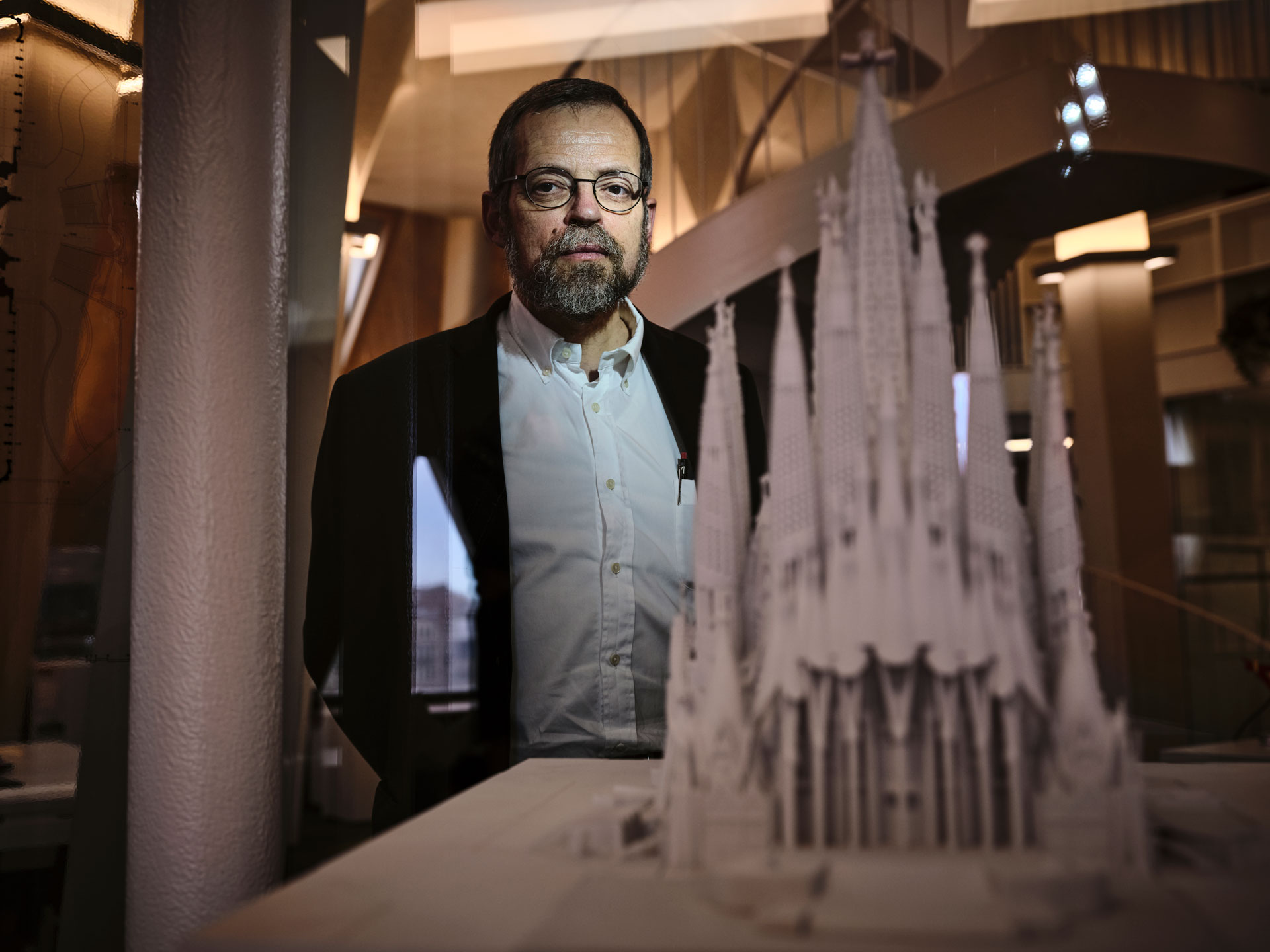Inside Barcelona’s Unfinished Masterpiece
The race to complete one of the world's longest-running construction projects
Clipped to the end of a giant red crane, the 25-ton panel — a marvel of stone and steel — begins its slow ascent. For the tourists gawking from the Barcelona street below, it’s an astonishing sight, this massive, chiseled slab dangling from a cord as it rises up the side of one of the world’s best known monuments. But it’s even more amazing for Jaume Oromí. As one of the heads of construction for the Sagrada Familia, Oromí has watched for months as, piece by piece, the towers that will one day remake the Barcelona skyline gradually rise into the heavens. “This is always the moment of maximum tension,” he says, gesturing to the panel as it sways 100 ft. above his head. “Intellectually, you know how it works, but there’s still something about getting that many tons in the air that seems miraculous.”
The same could be said for the Sagrada Familia as a whole. More than 130 years after the first stone was laid — and with the proper building permits finally in place — the end is in sight for the Barcelona basilica. Thanks to an influx of funding, some striking innovations and a lot of old-fashioned craftsmanship, the famously unfinished church is now on schedule to be completed in 2026, the 100th anniversary of the death of its architect, Antoni Gaudí. Today, more than two dozen architects are working on the project — most of them local Catalans — and 200 workers in total are involved in construction. But making the deadline will mean overcoming technical complications, theological doubts and several blocks’ worth of outraged residents.

At a time when Barcelona is grappling with an unprecedented tourist influx that is challenging the idea of what the city should be, the plans for the church risk deepening social and political divisions. And just like the reconstruction of Notre Dame in Paris, the project to finish the Sagrada Familia has triggered impassioned debates over the proper role of iconic historical buildings in a modern city.
But perhaps the greatest test will be determining its visionary creator’s intentions. “Gaudí left us the path,” says Jordi Faulí, the head architect now charged with the formidable task of completing a church that will have taken more than seven times as long to build as the great pyramid at Giza. “Sometimes, though, we’ve had to work hard to find it.”
Meet the team working to complete the Sagrada Familia by 2026.
When Gaudí died suddenly at the age of 73, struck down by a tram on a busy Barcelona street in 1926, the architect had been working on the Templo Expiatorio de la Sagrada Familia for 43 years. A religious organization hired the diocesan architect, Francisco de Paula del Villar, to build what was originally planned as a typical neo-Gothic church. But when Villar resigned a year after construction began, the project passed to Gaudí. Although he would go on to build several of Barcelona’s most iconic structures, including La Pedrera and Parc Güell, at the time, he had little more than a few lampposts and a shrine to his name.
It didn’t take him long, however, to transform the Sagrada Familia’s original plans into an extraordinarily ambitious undertaking: a structure that would combine natural forms and Christian symbolism into a temple that, as Faulí puts it, “expressed meaning not only through the sculpture and other decorations but through the architecture itself.” Gaudí was not a practicing Catholic when he received the assignment. But he became increasingly devout as he worked on it, eventually coming to see the very structure as a vehicle for Christian evangelism.
“My client,” Gaudí reportedly said, “is not in a hurry.” Aware that the Sagrada Familia would never be finished in his lifetime, he left extensive drawings and models for a building that, when complete, would fill an entire city block. He insisted on completing the Nativity entrance — even though there was not yet a nave to enter into — because he knew it would serve as a kind of inspirational advert for what was to come. He did not quite achieve the goal: that facade would not be finished until 1936. Otherwise, only the crypt, the apse’s facade and a single tower were complete at the time of his death. Everything else, including the remaining 17 towers and the central nave, remained undone.
For a long time, it stayed that way. During Spain’s 1936–39 civil war, construction stopped, and much of Gaudí’s preparatory work was destroyed. Even once it resumed, there were long stretches from the 1940s through the 1990s when insufficient funds — construction depended entirely on private donations — slowed or halted altogether the work. When Jordi Faulí joined the team as a junior architect in 1990, only three of the interior’s 56 columns (each one tied, in typical Gaudí fashion, to the liturgical calendar) and a handful of the windows had been completed.
But that was before the miracle of modern tourism. Although many in Barcelona would eventually see them as a curse, the millions of travelers who began flooding the city at the start of the new century meant salvation for the Sagrada Familia. As the number of visitors rose — the church currently gets roughly 4 million per year, and each one pays an entry fee that ranges from $16 to $43 — the foundation overseeing the basilica found itself in the unfamiliar position of having enough money to finish the main nave. A soaring expanse with tree-like pillars and multicolored stained-glass windows that make it feel like a kaleidoscopic forest, the nave was consecrated by Pope Benedict in 2010.

In the process of completing the interior, the architects realized something else wondrous: Gaudí, a master of pure geometry, had designed the entire complex using just two key forms: a hyperboloid (which can look like a 3-D hourglass) and a paraboloid (akin to a Pringles potato chip). Composed of straight lines (thereby making them easier to build) but creating curves (and enabling the naturalistic shapes Gaudí adored), the two structures were a sort of blueprint for the basilica’s different elements.
“It was like learning a new language — we weren’t just learning the vocabulary, but the grammar as well,” says Faulí. “Once we learned to form these shapes and combine them with each other, it was just a matter of following the rules he had laid out and applying them to new columns, new vaults.”
As the know-how and financing fell into place, the foundation began to study what it would take to actually finish the church. Which is how British structural engineer Tristram Carfrae, the deputy chairman of Arup, the design and engineering firm that built the Sydney Opera House, found himself walking out of a meeting in 2014 with the Sagrada Familia foundation and thinking, “Did that really happen? Do we really have the opportunity to work on the most fantastic project in the world?”
They did. But they still had to build 10 more towers, among them the 564-ft. Jesus tower, which would be the tallest structure in town. There were other daunting questions. “How do we speed up the rate of construction by a factor of 10 so that we can complete this by 2026?” Carfrae reels off. “How do we account for the fact that as you complete the church, the available area on site for assembling things diminishes? And finally, how do we do all that with the quality that the church deserves and Gaudí’s vision demands?”
Part of the answer lies at Galera, a sprawling work site 90 minutes north of Barcelona, where twin cranes rise like latter-day monoliths over the hills. Like each of the 50 or so workers there, Valentí Anglès has a very specific job: he uses a small, motorized crane to slide multi-kilo “anchor” blocks onto an interlocking row of granite stones that will be fixed to a steel plate and bound together into panels. Because the anchor blocks have holes through which steel rods will be inserted, Anglès can only afford an exceedingly tiny margin of error. “If I miss it by a millimeter or two,” he says, “we have to break the whole thing and start over.” The panels that Anglès helps build are Arup’s solution to the complex problem of building the Sagrada Familia’s towers. To make them light enough, the engineers could have built a steel frame and clad its surface with stone. “That didn’t fit with our notion of quality — from the inside it would have looked like a Hollywood set,” says Carfrae. Instead, they make the panels entirely of stone — albeit blocks only 300 mm thick, rather than a cathedral’s more typical 1 or 2 m.

That the panels can be prefabricated off-site matters too. There are masonry and carpentry workshops on the grounds of the Sagrada Familia itself, but the craftspeople there tend to work on the smaller decorative elements, since they lack the space to put together a single 6 m stone panel. But with 900 panels in all to make for the Jesus, Mary and four evangelist towers, even the Galera site isn’t big enough to hold everything at once.That’s why the Sagrada Familia has adopted a model that would be familiar to anyone who grew up in Detroit. The key components of stone (which come from different quarries around the world in an effort to match the polychrome stone that, in Gaudí’s time, came from Barcelona’s own Montjuïc hill, on its southern edge) and steel are prepared elsewhere. In northwestern Spain, for example, blocks of stone are precision-cut by computer, before a guy with a massive hammer slams the surface to create the textured exterior. “There’s a symbiosis of high tech and traditional artisanship in every component,” says Fernando Villa, the Sagrada Familia’s director of operations. “The process of bringing them together is modeled on an automobile assembly line. Everything is done just in time.”
So far, about 400 of the panels have been completed, loaded onto a truck bound for Barcelona and hoisted into place on the Sagrada Familia’s ever evolving roof. But if the technical challenges have been largely resolved, the social and political ones are proving a bit thornier.
When work first began on the Sagrada Familia, the temple was surrounded by empty land that had not yet been incorporated into Barcelona. That led Gaudí to design the temple’s main facade, dedicated to the glory of God, with a huge narthex that would extend from the southern terminus of the nave down a grand staircase to a park below. But today, the busy Calle Mallorca runs through the planned portico, and apartment buildings stand where the staircase and park are meant to go.

The city government had not yet taken a stand on how to resolve the issue, largely because it’s been too busy figuring out how to get the construction itself legalized. “It was always rumored that Sagrada Familia had never registered for the proper building permits,” says Janet Sanz, deputy mayor for the environment, urban planning and transportation. “When I took office, I asked my team to look into it, and we saw that for more than 130 years, they had been building without a license.”
That finally changed on June 7. Sanz made a point of requiring the foundation not only to acquire the proper permits, but also to compensate the city for the effects of a century’s construction. The Sagrada Familia’s own board seemed eager to rectify the situation as well, and, in addition to acquiring the permits and paying construction taxes amounting to €4.6 million, they agreed to pay an additional €36 million over the next decade to cover the costs of everything from security to building a metro entrance that directs tourists into the church, rather than aboveground.
But the agreement doesn’t address the facade-size elephant in the room. “I know that Sagrada Familia would like it if we kicked everybody out and razed the buildings on Calle Mallorca,” says Sanz. “But it’s not that simple. We’re already in moment of tourist saturation. How do we guarantee that the neighborhood isn’t converted into one giant souvenir stand? How do we keep traffic flowing? And when we already have a shortage, is destroying more housing the best solution?”
Both parties seem content to kick the decision down the road. Which is why every month, 150 or so residents — of the estimated 3,000 who could be evicted — march along the southern edge of the church bearing placards showing apartment buildings being squashed beneath a foot adorned with the same silhouette going up 100 m above their heads. “I don’t consider the church the enemy,” says Salvador Barroso, spokesperson for the protesters. “It’s their property, and they can dance folkdances in it for all I care. But when it encroaches on my property, what am I supposed to do?” Like many of his neighbors, he blames the city government for failing to protect residents, and wants either a guarantee that he can stay in his apartment or fair compensation for moving. So far, neither is on the table.
Head architect Faulí is quick to emphasize that neither the staircase nor the surrounding green space is included in the 2026 deadline. “That,” he says with a gentle smile, “will be another phase.” So too will the decoration of the Glory facade, which Gaudí refrained from detailing. “How do you represent the Eternal Glory?” asks Faulí. “We know from his model that it will have four towers, and 16 immense lanterns over the entry. And we know that Gaudí was near the end of his own life, so we can intuit mystical elements, the glimpse of God. But figuring out what he intended for that, yes, sometimes that keeps me up at night.”
For Faulí, who like many on the construction team is a deeply religious man, the role of determining Gaudí’s vision is daunting. But he also finds profound meaning in the work. “Somehow, Sagrada Familia lifts everyone so that they bring their best to it. It’s transcendent.”

One day in the near future, the final panel will be lifted into place and the Jesus tower topped with a five-pointed illuminated cross. Ascending via elevator and then a final staircase, the visitor will be able to see Barcelona stretching below, its wide boulevards leading to the mountains in one direction and the sparkling Mediterranean in the other. For Jaume Oromí, the view from the platform where he oversees construction never ceases to make him feel closer to God. But what really moves him is to stand alone in the nave at night, after all the tourists have left, and to put a hand on one of those extraordinary columns that Gaudí designed. “Then you can feel it,” he says. “It speaks to you.”
Correction, June 28: The original version of this story misstated the plans for the Jesus tower. It will be topped with a five-pointed cross, not a five-pointed star.